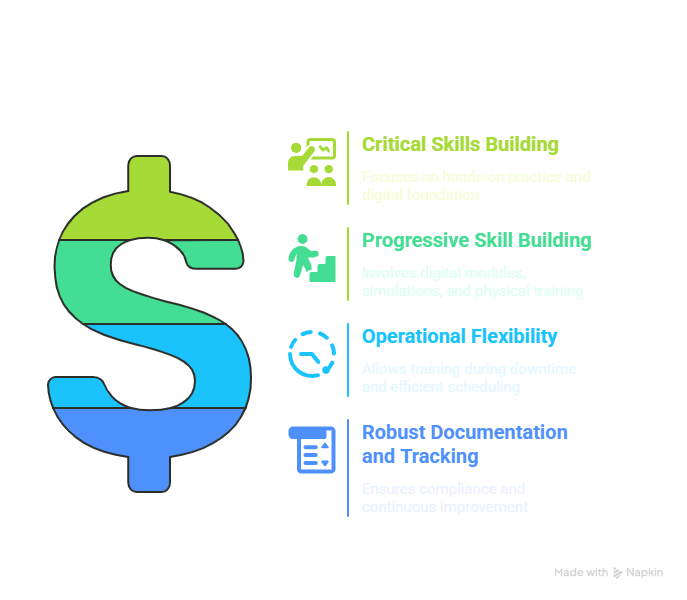
The cash-in-transit (CIT) industry stands at a critical crossroads. While the core mission of securely transporting money and valuables remains unchanged, the methods, threats, and regulatory environment continue to evolve. Modern CIT operations face sophisticated criminal tactics, complex compliance requirements, and increasing pressure to maintain operational efficiency without compromising security.
According to Dr Alice Maree, Incident and Analytics Manager at the Cash-In-Transit Association in South Africa (CITASA), more than 200 CIT robberies were recorded in 2024, a massive increase of 24% from 2023. With CIT robberies on the rise, there is a dire need for more effective cash-in-transit training to strengthen employee responses and make the industry safer.
Traditional training approaches—typically centred around classroom sessions and on-the-job shadowing—are becoming increasingly insufficient to address the threats CIT drivers and security personnel face daily. This is where eLearning and digital upskilling through Learning Management Systems (LMS)—including scenario-based learning—offer highly effective training solutions for high-risk cash transport operations.
Industry Challenges Driving the Need for Enhanced Training
- Evolving Security Threats
Few industries combine the pressures of physical security with the precision of financial accountability quite like CIT. Personnel are responsible for millions in valuables while potentially facing physical threats, creating unique psychological and operational stress. Criminal organisations increasingly use advanced surveillance techniques, electronic countermeasures, and detailed intelligence gathering to plan military-style attacks.
- Regulatory Complexity
CIT companies must navigate a complex web of frequently updated regulations, creating an ongoing compliance challenge. These updates may include:
- Anti-money laundering compliance
- Cash handling safety training and protocols
- Cross-border transportation requirements
- Industry-specific security certifications (PSIRA, SAPSA, CIT, SASSETA)
- SAPS firearm competency for handguns
- Vehicle and equipment standards.
- High Workforce Turnover
High turnover in the CIT industry is a significant issue. Low pay, limited career advancement, stressful work environments, inadequate training and development, and lack of emotional support can lead to low morale and job burnout. When a cash-in-transit employee “checks out,” they may not adequately handle crises, meaning they put themselves and others at risk.
How eLearning and LMS Transform CIT Training
Using an LXP (Learning Experience Platform) for your cash-in-transit training is a proven way to increase engagement and ensure employees are properly educated and supported. Here are examples of how you can use eLearning to upskill and train security personnel, drivers, and management.
Online Training For Security Personnel and Drivers
1. Scenario-Based Training
LMS platforms can deliver immersive, interactive scenarios that simulate real-world security situations. These allow personnel to:
- Practice situational awareness, threat detection, crisis management, and decision-making under pressure without real-world consequences.
- Learn defensive driving techniques for armoured transport.
- Experience multiple threat scenarios such as armed robberies, hijackings, and other security breaches that would be impossible to recreate in physical training.
- Receive immediate feedback on their choices and responses.
2. Continuous Microlearning
Rather than overwhelming security personnel with day-long training sessions, modern LMS platforms deliver bite-sized learning modules accessible on mobile devices, such as:
- Five-minute refreshers on specific procedures before shifts.
- Just-in-time training on new threats or protocols.
- Regular security awareness drills that build situational awareness.
3. Virtual Reality Integration
Advanced LMS platforms can incorporate augmented reality (AR) and virtual reality (VR) components, which are specifically valuable for CIT training, for example:
- Realistic cash handling practice with virtual currency.
- Firearm proficiency in high-pressure environments.
- Strategic convoy movement planning and route familiarisation without physical exposure.
- Emergency procedure rehearsal in lifelike environments.
4. Wellness Support
Customise your LMS platform to house wellness resources that address stress, prevent burnout, and help identify employees who might need additional support:
- Deliver mental health and stress management training.
- Facilitate peer support through forums and discussion boards.
- Provide access to professional mental health resources.
- Include interactive wellness check-ins and self-assessments.
- Track engagement with wellbeing content analytics to show participation in wellness programmes.
5. Compliance Certification Tracking
For personnel requiring multiple certifications, LMS platforms can automatically track:
- Certification expiration dates for CIT safety compliance training courses.
- Completion of continuing education requirements.
- Regulatory updates that might affect certification status.
Online Training For Management Personnel
1. Risk Assessment Training
Interactive modules providing risk management training for CIT teams will help employees to:
- Identify vulnerabilities in transportation routes.
- Assess facility security weaknesses.
- Analyse statistical trends in security incidents.
- Model potential threat scenarios.
2. Leadership Development
Management-specific training provides a focus on:
- Crisis leadership during security incidents.
- Team psychology in high-stress environments.
- Performance optimisation for security teams.
- Communication during emergency situations.
3. Analytics and Reporting
Training on using data-driven approaches teaches learners to:
- Analyse the effectiveness of security protocols.
- Identify patterns in near-miss incidents.
- Optimise route planning and scheduling.
- Benchmark operational efficiency.
4. Vendor and Client Management
Specialised modules may include:
- Security communication protocols with client institutions.
- Vendor risk assessment and management.
- Negotiating security requirements in contracts.
- Managing relationships during security incidents.
Blended Learning: The Ideal Approach for CIT Training
A blended learning approach combines physical and digital training to support both skill development and operational demands.
Here are some examples of how blended learning can be implemented:
Critical skills building: Hands-on practice is needed for the secure handling of cash and valuables, vehicle security procedures, physical defensive tactics, and the operation of specialised equipment. A blended learning approach ensures that these critical practical abilities are supported by a strong digital foundation that introduces key concepts and builds essential theoretical knowledge.
Progressive skill building: Learners are first introduced to concepts and procedures through digital modules. Simulations then help reinforce decision-making processes, followed by physical training where the knowledge is applied in real-world scenarios. Finally, digital assessments confirm retention and understanding, closing the learning loop.
Operational flexibility: With learners’ demanding schedules, eLearning for the CIT industry can be completed during their downtime, while physical training can be planned more efficiently. This approach allows for refresher courses without causing major disruptions and enables just-in-time training tailored to specific industry requirements.
Robust documentation and tracking: Clear records of training completion, comprehension levels, skills assessments, certification status, and areas that may require further focus ensure compliance and continuous improvement. The progress tracking feature in modern LMSs, for example, through platforms like aNewSpring, ensures that participation translates into tangible improvements in the lives of CIT security workers.

Implementation Best Practices for an LMS in High-Security Industries
Choose a platform designed for your industry’s unique demands, with features like military-grade security, mobile access for field teams, offline functionality, and robust compliance tracking. These features ensure secure, flexible learning that meets regulatory standards while accommodating operational realities.
Tailor training to specific job functions, such as:
- Defensive driving for vehicle operators.
- Cash handling for vault staff.
- Threat assessment for security teams.
Using real incidents from within the industry helps build relevant, engaging content through case studies, simulations, and scenario-based lessons.
Foster peer learning and collaboration through the LMS’s social features to create a space for peer-to-peer knowledge sharing and team discussions. Experienced staff can share insights, management can reinforce key practices, and exceptional achievements can be recognised.
Conclusion: The Security Advantage of Digital Learning
The most secure CIT operations of tomorrow will be those that embrace comprehensive digital learning today, combining the efficiency of eLearning with the practical experience of hands-on training. This blended approach to learning ensures that when faced with real-world security challenges, CIT personnel can respond with practised procedures, deep understanding, and adaptive decision-making capabilities.
For CIT companies looking to maintain a competitive advantage while enhancing security, adopting a digital learning infrastructure isn’t just a training decision—it’s a critical investment. Contact New Leaf Technologies for more information on scalable training for security and transport personnel.




